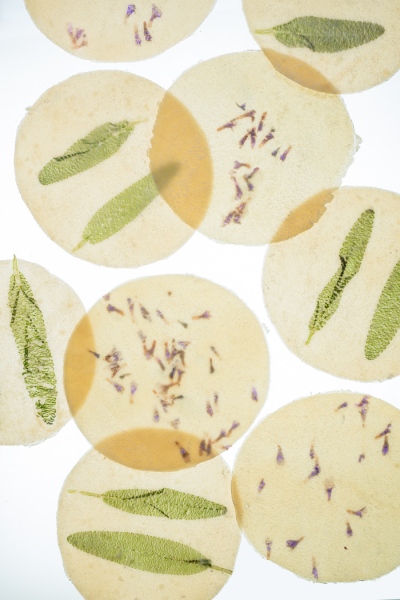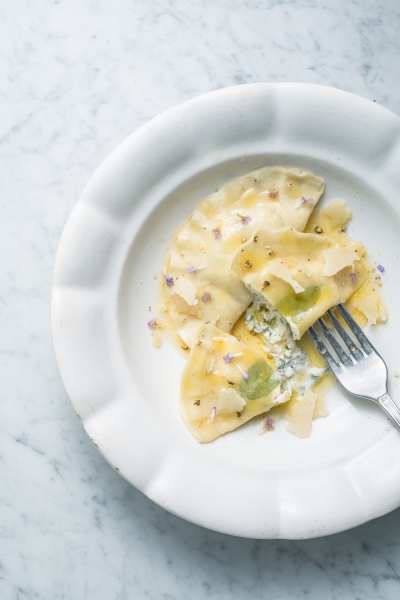Pasta e basta! Recently we visited Mario Gamba for a photo shoot in the Aquarello and were allowed to try the most delicious dishes – and what has flashed me the most: the fagottini with fresh peas. Magnificently light, like a peck. The dough was unbeatably thin and this is the important by well-made dumplings, of any shape, be it agnolotti, cappelletti, tortelli, tortellini, fragottini or just our ravioli. The pasta dough may only be the means of transport of the delicious filling and the sauce. Basta!

RAVIOLI
Zutaten
DOUGH
- 300 g of durum wheat flour semolina
- 3 eggs
- 1 tsp salt
- 1 handful sage leaves
- 1 handful lavender flowers
FILLING
- 250 g firm ricotta
- 150 g Parmesan
- 10 sage leaves, cut into fine strips
- Salt, Pepper
- 1 egg whisked
SAUCE
- 3 tbsp brown butter
- Parmesan fries
- Salt, Pepper
Zubereitung
DOUGH
- Put flour and salt on a work surface like a small mountain. Press with your fist a depression in the flour. Add the eggs to the well and whisk with a fork. Add flour to the egg mass from the outside and mix. When the mixture becomes a dough, continue working with your hands and knead the dough well for at least ten minutes. Then form the dough into a ball and leave for at least 30 minutes in a cling film.
FILLING
- Mix ricotta, parmesan, salt and pepper.
RAVIOLI
- Divide the dough into three parts. Roll out one part with the noodle attachment of the food processor to a long path (last setting = 5). When the dough sticks, add some flour. Cut the dough into circles of equal size with the back of the ravioliformer. Place two sage leaves on a circle and cover with another pasta circle. Again pass through the pasta machine (setting = 5) and cut out again to a circle. The same procedure applies to the lavender flowers, distribute about 10 flowers each on a circle. Process all three parts of the dough like this.
- Brush the pasta circle on the edges with the whisked egg. Flour the ravioliformer a bit and place the pasta circle in the ravioliformer. Then place the filling with a spoon in the middle of the dough, close the ravioli with light pressure, open again. Gently lift the finished ravioli out of the mold and place it on a floured surface.
FINAL
- Heat the brown butter in a high pan. Cook the ravioli in salted water. They are finished when they swim on the surface. Put the finished ravioli to the brown butter in the pan and stir. Serve immediately with the Parmesan shavings, salt and pepper.
Notes
Tip: If you do not want to eat all the ravioli the same day, you can cook them and keep them in the fridge for up to a week.
Useful Information
Italian flour – Distinction in durum wheat or common wheat
In Italy, flours are classified less by the degree of flour milling, but by the starting material. Whatever is ground from common wheat, the Italians call Farina, while they call everything from durum wheat (grano duro) Semola. Then comes the subdivision into tipo 00 to tipo 2 and integrals for wholegrain flour. An important difference between the two types of wheat is the protein composition. Durum wheat contains a much higher proportion of gluten than common wheat (13.6 percent to 10.9 percent). In addition, the gluten of durum wheat has a different structure: The starch granules are more firmly bound and are not so easily washed out during cooking, this leads to a higher cooking and bite resistance. Durum wheat is mainly used as a raw material for durum wheat semolina, short crust pastry, noodles, bulgur and couscous. Common wheat is used for the production of flours, which are ideal for baking cakes, bread and rolls.
Cultivation
Durum wheat is a grain that needs a warm and sunny climate for optimal growth, as prevails especially in the northern Mediterranean. Southern Italy, and above all Apulia, were already regarded as the granary of Italy in ancient times and are therefore the cradle of pasta culture. In Germany, the cultivation volume of durum wheat is VERY low. It is climatically limited to a few regions, such as in dry areas in the east and the wine-growing regions in the southwest of Germany. It is estimated that around 80 percent of demand is imported.



